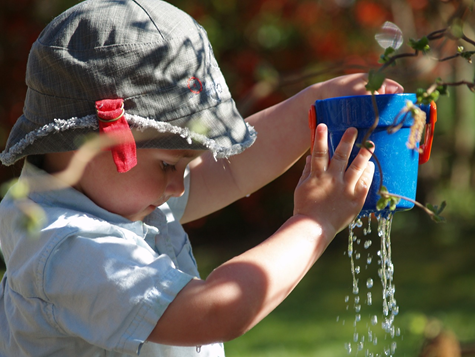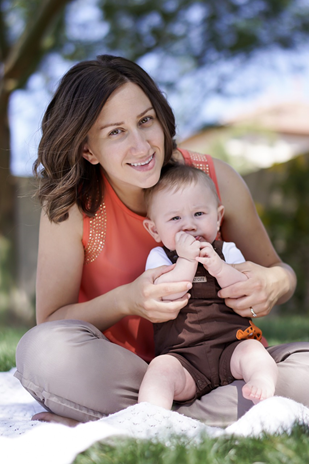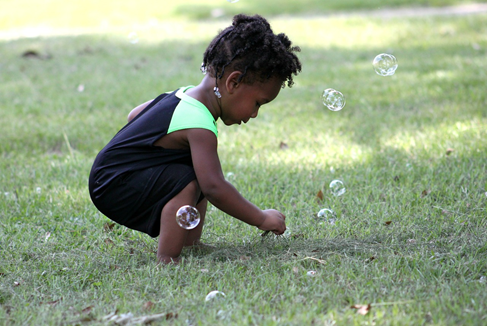10.7: Experiences that support Cognitive Development
- Page ID
- 139908
Cognitive Development and Experiences
The overall value of high quality experiences infants and toddlers receive during childcare supports their cognitive development. High-quality, center-based childcare during the first three years of life shows benefits for children's cognitive, language, and social development at school entry and beyond, across a range of national contexts (Albers, Riksen-Walraven & de Weerth, 2010; Barnes & Melhuish, 2017; Burchinal et al., 2000; Camilli, Vargas, Ryan, & Barnett, 2010; Drange & Havnes, 2019; Eryigit-Madzwamuse & Barnes, 2014; Hansen & Hawkes, 2009; Melhuish et al., 2015; Melhuish & Gardiner, 2017; National Institute of Child Health and Human Development Early Child Care Research Network, 2000; Ruzek et al., 2014). These effects are particularly pronounced in children from disadvantaged backgrounds (Connell & Prinz, 2002; Felfe, Nollenberger, & Rodríguez-Planas, 2015; Geoffroy et al., 2007, 2010; Larose, Côté, Ouellet-Morin, Maughan, & Barker, 2020; Melhuish, 2004; Melhuish et al., 2015), meaning that investment in early childhood education and care is a powerful way of reducing socioeconomic inequalities (Bustamante et al., 2021; Center on the Developing Child, 2010; Heckman, 2006; Reynolds, 2021). [1]

While the benefits of center-based childcare is well documented, the quality of care and education for infants and toddlers is not created equal as numerous studies have documented dramatically different differences in childcare quality (Kuchirko & Nayfeld, 2020; Kuchirko & Tamis-LeMonda, 2019). In a national study of Early Head Start center-based programs for infants and toddlers in the U.S., most classrooms were of midrange quality with higher scores in the area of emotional and behavioral support and lower scores in the area of engaged support for learning (Vogel et al., 2015). The National Institute of Child Health and Human Development (NICHD) Study of Early Child Care is one of the largest research projects on early childcare in the U.S. and has followed over 1,000 children longitudinally to measure the long term impact of experiencing high quality infant and toddler childcare. Children who received higher quality care as infants and toddlers scored higher on cognitive tests across the first three years and all the way through adolescence (Belsky, 2006; NICHD Early Child Care Research Network, 2001; Vandell et al., 2010). Importantly, caregiver language (asking questions, responding to child vocalizations, etc.,) was the strongest predictor of cognitive development. [3]
The research is clear: high quality infant and toddler care is important for supporting cognition, but what does high quality care look like? The overall quality of care and education for infants and toddlers is commonly separated into two components—structural quality and process quality (Beller et al. 1996; Howes & Rubenstein, 1983; Penn, 2011; Phillipsen et al., 1997). Structural quality refers to components such as the physical environment (buildings, space and materials), child–staff ratios, staff education and training, and curriculum (Barros et al., 2016; Slot et al., 2015; OECD, 2006). On the other hand, process quality focuses on the nature of interactions between the children and caregivers, among children, and among adults—teachers, parents, staff, and on the nature of leadership and pedagogy (Barros et al., 2016; Cryer 1999; Goelman et al. 2006; Slot, 2017; Thomason & La Paro, 2009; Vandell and Wolfe 2000). Structural quality is easier to measure although process quality may be more strongly related to greater developmental outcomes. [4]

There are various tools that can be used to measure structural and process qualities. One commonly used tool is the Infant-Toddler Environmental Rating Scale Revised Edition (ITERS-R; Harms et al. 2006), used to measure the overall quality of classrooms serving children from birth through 30 months of age. The ITERS-R includes 39 items, organized under 7 subscales: Space and Furnishings (5 items); Personal Care Routines for infants and toddlers (6 items); Listening and Talking (3 items); Age Appropriate Activities (10 items); Adult–Child Interaction (4 items); Program Structure (4 items); and Parent and Staff Communication (7 items). [4]
ITERS-R Items and Subscales. [4]
Space and Furnishings
- Indoor space
- Furniture for routine care and play
- Provision for relaxation and comfort
- Room arrangement
- Display for children
Personal Care Routines
- Greeting/departing
- Meals/snacks
- Nap
- Diapering/toileting
- Health practices
- Safety practices
Listening and Talking
- Helping children understand language
- Helping children use language
- Using books
Age Appropriate Activities
- Fine motor
- Active physical play
- Art
- Music and movement
- Blocks
- Dramatic play
- Nature/science
- Promoting acceptance of diversity
Adult–Child Interaction
- Supervision of play and learning
- Peer interaction
- Staff–child interaction
- Discipline
Program Structure
- Schedule
- Free play
- Group play activities
Parent and Staff Communication
- Provisions for parents
- Provisions for personal needs of staff
- Provisions for professional needs of staff
- Staff interaction and cooperation
- Staff continuity
- Supervision and evaluation of staff
- Opportunities for professional growth
Using the ITERS, scores of overall quality range from ‘inadequate’ (score of 1) to ‘excellent’ (score of 7), with a ‘minimum’ (score of 3) and ‘good’ (score of 5) in between. Studies that have used the ITERS to assess quality have found low scores in general. Research in the U.S. has found quality scores of infant and toddler programs to be in the low to medium range (La Paro, Williamson & Hatfield, 2014; Tietze & Cryer, 2004). For example, one study examined the quality of 93 toddler programs across the state of North Carolina and found that 83% of the programs were in the mid-range, with scores between 3 to 5 (La Paro, Williamson & Hatfield, 2014). While childcare centers in the U.S. score higher in overall average quality compared to most other countries, there is more variance in the quality of U.S. programs compared to other countries (Vermeer et al., 2016). Higher than average quality scores have also been found in Australia (Fenech, Sweller & Harrison, 2010).
ITERS scores from around the world are low. Results from studies in the Netherlands found an overall quality score on the ITERS to be at the minimal level, with an average score of 3, and showing a downward trend in quality over time (Helmerhorst et al., 2015; Vermeer et al., 2008). Seventy-five childcare centers in Eastern and Western Germany had an average ITERS score of 3.2 (Tietze & Cryer, 2004). Three studies in Portugal reported poor-quality care and education with scores all under 3 (Barros & Aguiar, 2010; Pessanha et al., 2007; Pinto et al., 2013). Results from a study of 93 centers in Norway found a minimal average quality of 3.9 (Bjørnestad & Os, 2018). In Greece, infant and toddler programs ranged between 2.60 to 5.40 using ITERS (Megalonidou, 2020). In England, 75 childcare centers were assessed and found to have a mean score of 4.2 (Smith et al. 2009). Chile reported an ITERS score between 3 to 4, with public childcare centers (3.08) scoring lower than private centers (3.57) (Cárcamo et al., 2014). Across seventy-nine infant and toddler classrooms from Jinan, in the Shandong province in eastern China, the overall mean score was 3.50 (Hu et al., 2019). Overall quality was low in Ecuador with an average score of 2.08 (Lopez Boo, Dormal & Weber, 2019). [4]

What is the take away message for infant and toddler caregivers?
- Quality of learning experiences during the first three years is related to later cognitive abilities.
- Infants and toddlers who attend center-based programs of higher quality have higher cognitive scores later in childhood and adolescence.
- The overall quality of care and education infants and toddlers experience can vary widely.
- While programs in the U.S. tend to receive average quality scores in the midrange and above, U.S. programs have been found to vary greatly in quality.
- While a handful of countries receive quality scores in the midrange and above, many more countries consistently receive scores of low quality, emphasizing the importance of education and training for infant and toddler caregivers and staff.
- Caregivers can use measures of program quality, such as the ITERS-R, to assess the quality of their programs, identify areas of lower performance and strive to improve.
- As process quality may be more strongly related to cognitive development than structural quality, caregivers can seek to actively improve their abilities and strategies for engaging with infants and toddlers, especially in terms of language exposure.
Another tool that can be used to measure the quality of interactions between caregivers and children is the The Classroom Assessment Scoring System (CLASS). The CLASS defines teaching quality through the lens of interactions. It provides the ability to measure and improve the interactions that matter most for student outcomes. Implementing a tool like the CLASS can provide data which can be used to provide professional development and improve overall quality.
[1] Davies et al., (2021). Early childhood education and care (ECEC) during COVID‐19 boosts growth in language and executive function. Infant and Child Development, e2241. CC by 4.0
[2] Image from igrow on Pixabay.
[3] Vogel et al., (2015). Toddlers in Early Head Start: A portrait of 2-year-lds, their families, and the programs serving them. Vol 1: Age 2 report. OPRE report 2015-10. Administration for Children & Families. In the public domain.
[4] Megalonidou (2020). The quality of early childhood education and care services in Greece. International Journal of Child Care and Education Policy, 14(1), 1-12. CC by 4.0
[5] Image by ImagesBG on Pixabay.
[6] Image by cherylholt on Pixabay.

